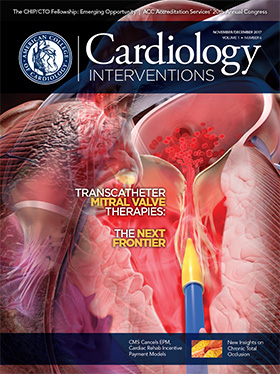Quality Improvement | New Risk-Standardization Model Validated for IMPACT Registry
The creation of a risk-standardization model for adverse outcomes following congenital cardiac catheterization will lay another brick in the path towards quality improvement for participants in ACC’s IMPACT Registry, according to a study published in Circulation.
Natalie Jayaram, MD, MSB, FACC, et al., note that the IMPACT Registry collects data on over 200 different types of interventional procedures. Given the lack of feasibility to adjust for each procedure individually, a committee of eight subject matter experts were convened to review the IMPACT case report form and determine the adverse events that constituted a major adverse event (MAE). Cardiac arrest requiring CPR, embolic stroke within 72 hours of cardiac catheterization and subsequent cardiac catheterization due to complication were among the more than 15 defined events.
Using the IMPACT Registry, researchers identified 39,725 patients who underwent cardiac catheterization at 74 centers in the United States between January 2011 and March 2014. They randomly selected 70 percent of the total study population for the derivation cohort and 30 percent for the validation cohort. The mean patient age was 9.7 years and the most common comorbidity was chronic lung disease (6 percent of patients). One in 10 had a reportable genetic condition, while one in five had single ventricle physiology.
The study authors note that a MAE occurred in 7 percent of cases, and a similar occurrence rate was found in both derivation and validation cohorts (7.1 percent vs. 7.2 percent, p = 0.84). Six procedure-type risk categories and six independent indicators of hemodynamic vulnerability were identified. Procedure-type risk category, number of hemodynamic vulnerability indicators, renal insufficiency, single-ventricle physiology and coagulation disorder were all included in the final risk adjustment model.
Results showed the most common events were bleeding (1.4 percent), an arrhythmia requiring antiarrhythmic medication (1 percent) and death during hospital admission following cardiac catheterization (2 percent). Neonates were more likely to experience a MAE compared with children or adults (22.2 percent vs. 4.3 percent), as were those with a genetic condition compared with those without a documented syndrome (10 percent vs. 6.8 percent).
Building upon prior efforts (Boston Children’s Hospital and the CHARM model), the risk-standardization methodology can be incorporated into the registry’s quarterly metric reports. The study authors write this will “lay the foundation for comparing outcomes across institutions participating in IMPACT, while accounting for both the types of patients they treat and the types of procedures they perform.”
“In an era where transparency and public reporting of outcomes is becoming increasingly embraced, the ability to report risk-standardized rates of major adverse events is crucial,” they continue. “Individual practitioners and institutions are much more likely to support public reporting if they feel that these data represent a fair and accurate assessment of their performance and reflects the acuity of their patient population.”
Keywords: ACC Publications, Cardiology Interventions, Child, Infant, Newborn, Risk Adjustment, Quality Improvement, Research Personnel, Hemorrhage, Cohort Studies, Heart Arrest, Cardiac Catheterization, Arrhythmias, Cardiac, Registries, Comorbidity, Hemodynamics, Stroke, Renal Insufficiency, Lung Diseases, Cardiopulmonary Resuscitation
< Back to Listings

